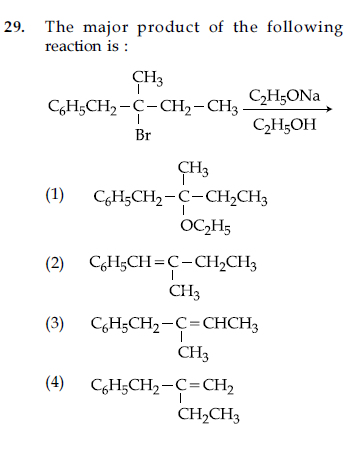I can see that due to the substrate being bulky, an elimination reaction will take place and not substitution. The reagent is a strong base. E1 reactions are independent of the base chosen, and E2 requires strong base. There is no information about the geometry of the substrate (i.e., whether the beta hydrogens are anti to the halide). How do I decide between the two mechanisms?

-
3$\begingroup$ I’m not sure that the E1/E2 question is as important for answering what the major product is. Just think about which hydrogen is most acidic. $\endgroup$– ringoCommented Dec 22, 2018 at 8:09
-
$\begingroup$ Oh, I get it now. It is the beta hydrogen attached to the benzylic carbon. Since its removal would form a stable carbocation, that is where the elimination would take place, right? $\endgroup$– Ritwik OjhaCommented Dec 22, 2018 at 8:51
-
$\begingroup$ And now, since the reaction does depend on the stability of carbocations, can I say it proceeds through E1? Or is there still no conclusion to be drawn about that? $\endgroup$– Ritwik OjhaCommented Dec 22, 2018 at 8:52
-
$\begingroup$ What do you mean about the geometry of the substrate? $\endgroup$– KarlCommented Dec 22, 2018 at 12:40
-
$\begingroup$ That was about the anti geometry required between the beta hydrogen and the halide, in order for E2 to take place. $\endgroup$– Ritwik OjhaCommented Dec 22, 2018 at 12:42
1 Answer
You have a tertiary halide. These dissociate rather easily into the relatively stable tertiary carbocation and the free anion. That in and by itself should be indication enough that the reaction proceeds via E1. Alcoholates are only moderately strong bases so the mechanism cannot be $\mathrm{E1_{cb}}$.
You could consider E2 because the substrate is non-cyclic which means that it can always orient itself in such a way that a hydrogen atom is anti with respect to the halide. The only thing to take care of is steric hindrance; just draw the appropriate Newman projections to determine the likelyhood.
Once you have the tertiary carbocation, any of the β hydrogens could dissociate. You would likely initially get some kind of mixture based on the corresponding $\mathrm pK_\mathrm a$ values weighted by the number of hydrogens. Looking at the three different carbons, one is obviously much more acidic because it is benzylic. This explains the major product.
Even if initially another hydrogen is deprotonated, you can assume that equilibration takes place towards the conjugated styrene system given catalytic excess base.
